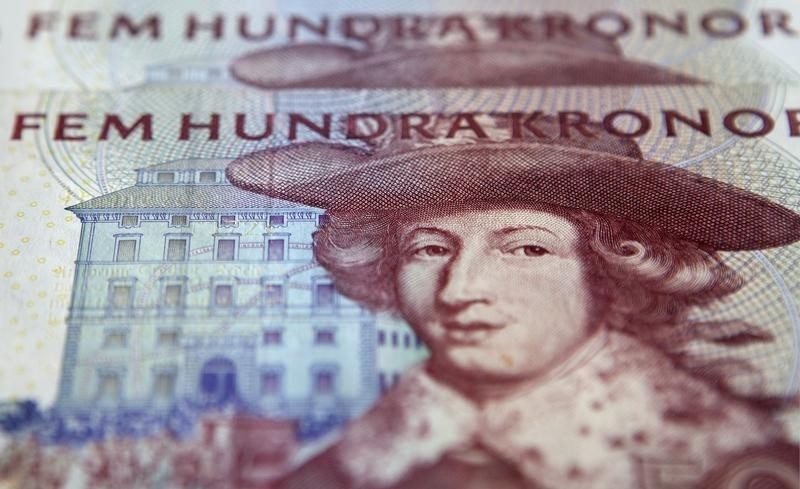By Saikat Chatterjee
LONDON (Reuters) - The Swedish crown's struggle as one of the whipping boys of European currencies may be nearly over.
Despite a reasonably bright economy and red-hot property market, Sweden's Riksbank has fought furiously against crown strength in recent years and there is intensifying speculation it may be about to relent when it meets this week.
In the Riksbank's battle against dangerous overvaluation of the crown during a period of extraordinarily loose monetary policy at the European Central Bank, Sweden's official interest rates have been slashed to the second lowest in the world.
The Riksbank's main policy rate stands at a minus half a percentage point, more deeply negative than the ECB's at minus 40 basis points and Japan's at minus 10 basis points. Only Switzerland, at minus 75 basis points, is more negative.
Even though the contrast between these sub-zero rates and the economy's brisk growth prospects and red-hot property market attracted some funds towards the crown earlier this year, its weakness persisted and forced many to cut and run.
But with market positioning much more lighter and Sweden's central bank likely to follow its Norwegian and European counterparts in gradually unwinding years of unconventional policy stimulus, there is renewed optimism about the unit.
John Taylor, a fixed income portfolio manager at Alliance Bernstein in London who purchased the Swedish crown against the euro around the 10 kroner per euro, said the odds are increasing for the Riksbank to start rolling back its unconventional policies this week.
"The economy is doing well and the Riksbank officials have become less comfortable with the currency’s weakness in recent days, suggesting that they might follow the Norges Bank in signalling a quicker path for interest rate normalization."
A majority of analysts in a Reuters poll published last week see the Riksbank signalling an end to the current quantitative easing programme and keeping interest rates steady at a policy decision on Wednesday.
Norway's central bank, which also has its main policy rate at minus 50 basis points, surprised markets last week when it suggested that it will start raising interest rates as early as next year, compared to market expectations of late 2019, sending its currency higher against its major rivals.
LIGHT POSITIONS
The crown's near 7 percent decline against the euro (EURSEK=D3) over the last three months has pushed investors out of their long positions. They had added bets in the first half of the year.
"Market positioning is very light as long positions have become steadily unwound in recent weeks thanks to the euro's move higher against the kroner," said Michael Sneyd, global head of FX strategy at BNP Paribas (PA:BNPP) in London.
Derivative markets are also indicative about the light positioning in the foreign exchange markets with one-month risk reversal, an indicator of how much crown calls are purchased relative to puts, falling substantially from a one-year high hit earlier this year.
To be sure, some investors such as Alastair Smith, partner at Harmonic Capital Partners, a hedge fund in London, said the quality of the inflows into Swedish equity markets showed that long-term investors still remained wary of the currency.
"We don't think the Swedish currency is out of the woods yet judging by the quality of the capital flows that has gone into the local equity markets," Smith said.
But bond markets have proved to be a different story.
Investors have been drawn to Sweden's covered bonds which boast of a "AAA" rating, backed by mortgages, and offer a juicier yield pickup than its counterparts in the government bond markets.
Moreover, unconventional monetary policies pursued by the Riksbank in recent months have meant that maturities up to 10-year segments are heavily owned by the central bank with scarcer yields than available elsewhere.
"We like the Swedish covered bonds market as that offers a juicier yield pickup of about 50-70 basis points compared to the government bonds space," Bernstein's Taylor said.
(For a graphic on Sweden Europe Growth click http://reut.rs/2kwmysp)
DOMESTIC FACTORS
In Sweden's case, domestic factors have clouded the currency's outlook, particularly housing prices that have doubled in the last decade and made some investors wary of a sharp downturn that might hurt the broader financial system.
While regulators have forced banks to hold bigger buffers to mitigate the risks, one macro strategist at a hedge fund in London said the housing price situation was "the major factor for unwinding long Swedish crown bets."
The crown has fallen nearly 4 percent so far this year against the euro (EURSEK=), outstripping the 3.4 percent decline of the British pound against the euro (EURGBP=).
Growing annual pension fund-related outflows have also played a part in weakening the crown to more than 10 crowns per euro, its lowest since November 2016 last week.
This year, annual outflows to overseas investments from Swedish pension funds will total 26 billion Swedish crowns ($3.07 billion) in December, the most in nearly two decades, according to Karl Steiner, chief quantitative FX strategist at Stockholm-based SEB.
Steiner said the crown may have likely peaked around the 10 per euro level and may head to 9.20 in the coming weeks if the Riksbank doesn't strike a dovish stance next week. "We are quite constructive about the currency's outlook," he said. (For a graphic on Sweden Bond Yields click http://reut.rs/2kyhmV4)
